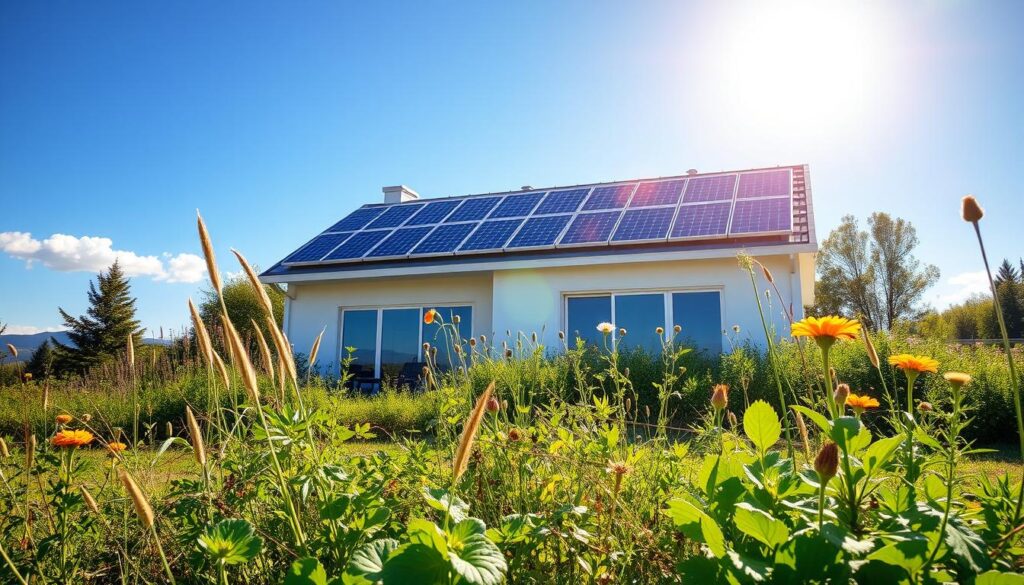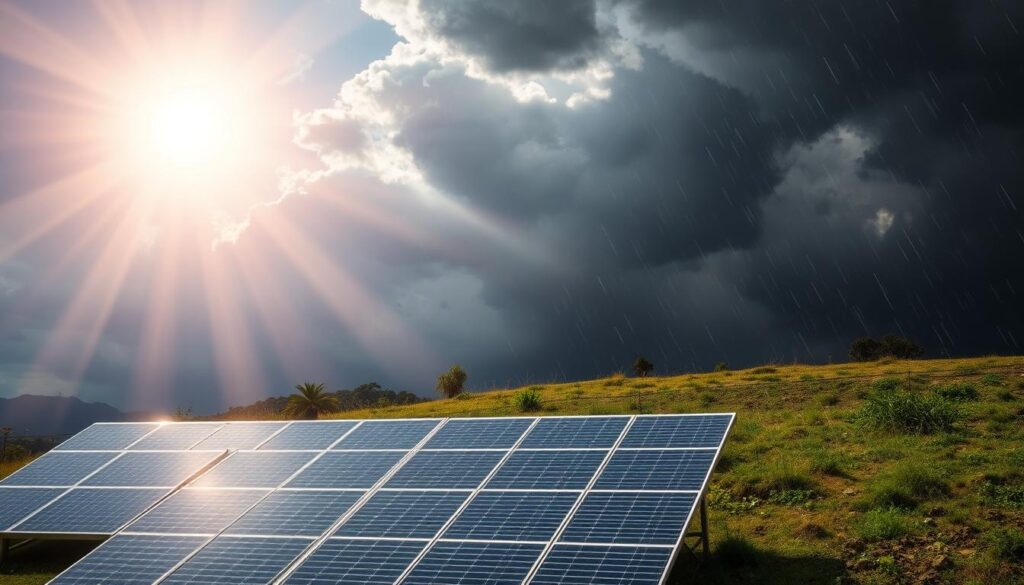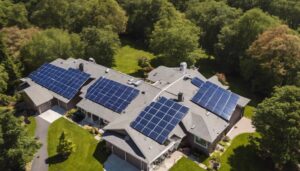Did you know that solar panels can last 25 to 30 years, and every dollar you save on your electrical bills by going solar can increase your home’s value by $20? With the recent advancements in solar technology, the choice to transition your household to renewable energy has become increasingly compelling. However, the decision to install solar panels involves weighing both the advantages and disadvantages of this renewable energy source.
As you explore the possibility of harnessing the power of the sun, it’s essential to understand the multi-faceted nature of solar energy. While it offers an eco-friendly, renewable, and potentially cost-effective solution, there are also considerations around the high upfront costs, weather dependency, and the environmental impact of manufacturing and disposing of solar panels.
Key Takeaways
- Solar energy is a renewable and sustainable source of power that doesn’t produce greenhouse gas emissions.
- Installing solar panels can significantly reduce your monthly electricity bills, potentially saving you thousands over the system’s lifetime.
- Solar energy systems can provide energy independence and reliability, protecting against power outages and fluctuating energy prices.
- The high upfront costs of solar panel installation can be a significant financial barrier for some households.
- Solar energy’s performance is dependent on weather conditions, which can impact its reliability and consistency.
Renewable and Sustainable Energy Source
Solar energy is a renewable and sustainable source of power that does not produce greenhouse gas emissions or other pollutants, making it an environmentally friendly alternative to fossil fuels. Unlike finite resources like oil and natural gas, which release harmful byproducts when burned, solar energy taps into the sun’s abundant and renewable rays to generate clean electricity. This renewable nature of solar power has the potential to significantly reduce our reliance on fossil fuels and mitigate the environmental impact of energy production.
The largest solar energy plant in the world, the Bhadla Solar Park in Rajasthan, India, covers 10,000 acres and has an installed capacity of 2,245 megawatts, with an estimated investment of $1.4 billion. In the United States, the Solar Star park near Rosamond, California, is the largest solar installation, with a combined capacity of 579 megawatts from its two facilities, Solar Star-1 and Solar Star-2.
Solar energy is a sustainable power source that offers numerous benefits, including low operating costs, job creation opportunities, and the potential to combat climate change by reducing greenhouse gas emissions. With the federal solar investment tax credit providing a 26% tax credit for solar panel installations, solar energy is becoming increasingly cost-competitive with traditional fossil fuels, making it an attractive option for both residential and commercial properties.
“Approximately 173,000 terawatts of solar energy shine on Earth each day, which is 10,000 times the daily global energy use.”
However, there are some challenges associated with solar energy, such as intermittency in energy generation, land use requirements, and concerns about the scarcity of materials for solar technologies. Additionally, the high initial costs of solar panel installation can be a barrier for some individuals and businesses.
Despite these challenges, the renewable and sustainable nature of solar energy, coupled with its environmental benefits and the potential for cost savings, make it a compelling option for a more sustainable future. As technology continues to advance and costs decrease, the adoption of solar energy is expected to grow, contributing to a cleaner, more eco-friendly energy landscape.
Reduced Electricity Bills
Going solar can significantly reduce your monthly electricity bills by generating free energy from the sun’s rays. Installing a solar panel system has the potential to save you thousands of dollars over the lifetime of the system, making it a cost-effective investment for many homeowners.
According to recent statistics, solar energy can save homeowners up to £915 per year on their electricity bills. This is because solar panels produce electricity on-site, reducing your reliance on the grid and the associated charges. Additionally, the Smart Export Guarantee (SEG) allows you to earn money by selling any surplus energy you generate back to the grid, further offsetting your electricity costs.
Solar panels typically come with a 20-25 year warranty from reliable manufacturers, ensuring long-term cost savings. Moreover, the maintenance costs for solar systems are relatively low, with only around £25-£35 required for each cleaning session. This means that the initial investment in solar panels can provide substantial cost savings and long-term savings on your reduced electricity bills over the life of the system.
“Installing solar panels can significantly reduce your monthly electricity bills and potentially save you thousands of dollars over the lifetime of the system.”
Low Maintenance Costs
One of the key advantages of solar energy is its low maintenance requirements. Once your solar panel system is installed, it requires minimal upkeep to continue generating clean, renewable power for your home or business. Solar panels are designed with durability in mind, with few moving parts and a simple, streamlined construction that can withstand various weather conditions.
Solar energy systems have an average lifespan of 25-30 years, and even after three decades of use, they typically maintain an efficiency rating of 85% or better. The occasional need for professional inspections or cleanings is relatively infrequent and affordable, with costs ranging from $140 to $180 for a full service.
Homeowners with solar panels can also benefit from the warranties that often accompany these systems, providing performance guarantees and further reducing the long-term maintenance costs. Additionally, the lack of complex mechanisms in solar panels means there is a low risk of mechanical failures, allowing you to enjoy a worry-free, low maintenance energy solution for years to come.
“Solar panels have incredibly low maintenance costs compared to traditional energy sources, reducing the financial burden of constant upkeep.”
While the initial investment in solar panel maintenance or a solar system maintenance can be significant, the long-term savings and peace of mind make it a worthwhile investment for many homeowners and businesses. With minimal upkeep required, solar energy continues to provide a reliable, low maintenance power source that can contribute to significant cost savings over time.
Energy Independence and Reliability
Solar energy systems can provide homeowners with a remarkable degree of energy independence and reliability. By generating electricity on-site, solar power reduces reliance on the traditional electrical grid, shielding households from power outages and fluctuating energy prices.
One of the key advantages of solar energy is its ability to function as an emergency backup during grid disruptions. When paired with a solar battery storage system, a home’s solar panels can continue to provide power even when the broader network experiences an outage. This ensures a steady, uninterrupted supply of electricity, enhancing overall energy reliability.
Moreover, solar energy systems enable homeowners to take advantage of energy arbitrage through net metering. By storing excess solar electricity in batteries and strategically drawing from the grid during off-peak hours, households can optimize their energy usage and maximize cost savings.
| Benefit | Statistic |
|---|---|
| Cost Savings | Solar panel systems typically break even within six-to-ten years, with panels lasting beyond 25 years, leading to long-term cost savings. |
| Job Creation | Solar accounts for 4.3 million jobs globally, making up more than one-third of all renewable energy jobs in 2021. In the USA, solar jobs grew by 3.5% in 2022, exceeding 250,000 people employed in the sector. |
| Affordability | Solar energy is the most affordable form of power generation in many regions, as per the levelized cost of electricity (LCOE). |
By embracing solar energy, homeowners can enjoy the benefits of energy independence, grid independence, power outage protection, and energy reliability, all while contributing to a more sustainable future.

Increased Property Value
Installing solar panels on your home can not only save you money on your electricity bills but also significantly increase the value of your property. According to the National Renewable Energy Laboratory, every dollar a solar panel saves you on your electrical bills increases the value of your home by $20. Furthermore, studies have shown that homes with solar panels sell for around 4% more than those without them.
The benefits of having a solar home are twofold: first, the long-term savings on electricity bills make the property more attractive to potential buyers, and second, the home resale value is higher due to the added value of the solar energy system. This means that if you decide to sell your property value in the future, you can expect to recoup a significant portion of your initial investment in the solar panels.
“Solar panels are becoming increasingly popular among homeowners due to their ability to generate electricity for domestic use, reduce energy costs, and increase property value.”
The growing demand for renewable energy solutions, coupled with government incentives and rebates, has made solar power an attractive option for many Australian homeowners. By embracing this clean and sustainable technology, you can not only save on your monthly bills but also position your home as an attractive and valuable investment for the future.
In conclusion, installing solar panels on your home is a smart investment that can pay dividends in the long run. Not only will you enjoy the financial benefits of reduced electricity costs, but you’ll also be contributing to a more sustainable future and potentially increasing the property value of your home.
What are the advantages and disadvantages of solar energy?
Solar energy is a versatile and increasingly popular renewable energy source that offers a range of advantages and disadvantages for homeowners and businesses to consider. By understanding both the pros and cons of solar energy, you can make an informed decision about whether it’s the right choice for your energy needs.
Advantages of Solar Energy
One of the primary advantages of solar energy is that it is a truly renewable and sustainable energy source. Unlike fossil fuels, which are finite, the sun’s energy is available every day, making it an inexhaustible resource. Solar power also produces no greenhouse gas emissions or other pollutants, making it an environmentally friendly option.
Another key advantage is the potential to lower your electricity bills. Solar panels generate free electricity from the sun’s rays, which can significantly reduce your monthly energy costs. In fact, studies show that every dollar saved on electrical bills by using solar panels increases the home’s value by $20, and homes with solar panels can sell for up to 4% more.
Solar energy also offers energy independence and reliability. By generating electricity on-site, you can reduce your reliance on the grid and protect against power outages and fluctuating energy prices. Additionally, solar energy has diverse applications, from electricity generation to water distillation and powering satellites.
Finally, solar energy systems require low maintenance costs, with specialized cleaning needed only a few times a year. Technological advancements in the solar power industry are continuously improving the effectiveness and efficiency of solar panels, making them an increasingly attractive option.
Disadvantages of Solar Energy
One of the primary drawbacks of solar energy is the high upfront cost of purchasing and installing a solar PV system. While the long-term savings can offset this initial investment, the initial cost can be a significant barrier for some homeowners and businesses.
Another disadvantage is the weather dependency of solar energy. Solar panels are less efficient on cloudy or rainy days, and the production of solar energy is lower during the winter months. The storage of solar energy in batteries can also be expensive, especially for off-the-grid systems.
Solar PV panels also require a significant amount of space for higher electricity production, which may not be suitable for smaller homes or properties with limited available roof or ground space. Additionally, solar panels may not work on certain roofing materials or historical buildings with obstacles like skylights or decks.
Overall, the advantages and disadvantages of solar energy must be carefully weighed to determine if it is the right choice for your energy needs. By understanding both the pros and cons, you can make an informed decision that aligns with your energy goals and budget.
High Upfront Costs
While solar energy can provide significant long-term savings on your electricity bills, the initial installation costs can be quite high, making it a substantial financial investment that may not be feasible for everyone. On average, a complete solar setup for a home in Australia can cost around $18,000 to $20,000 before accounting for any incentives or the federal solar tax credit.
The good news is that the costs of solar panels have been steadily decreasing over the past decade, with 54% of solar installers reporting a price decrease in 2023. Additionally, many local governments offer incentives such as tax breaks and rebates to encourage the adoption of solar energy, which can help offset the upfront costs. The federal solar tax credit also provides a 30% tax credit to homeowners who install solar panels.
Despite these cost-saving measures, the high upfront costs of a solar installation can still be a significant barrier for some homeowners. However, solar panels can pay for themselves in as little as 10 years through the energy savings they provide, making them a worthwhile long-term investment for those who can afford the initial financial outlay.
“The average household can save about $1,500 per year on electric bills when solar panels are installed.”
Ultimately, the decision to invest in a solar PV system depends on your personal circumstances and financial situation. It’s important to carefully consider the long-term benefits and potential cost savings before making the commitment to a high upfront financial investment in solar energy.
Weather Dependency
One of the primary advantages of solar energy is its renewable and sustainable nature, providing a clean alternative to traditional fossil fuels. However, the efficiency of solar power systems is heavily dependent on the weather conditions. Unlike fossil fuels, which can generate electricity regardless of the weather, solar energy’s reliance on sunlight can pose challenges in areas with less-than-ideal levels of sun exposure or poor weather patterns.
During cloudy or rainy days, the solar panels’ ability to convert sunlight into usable electricity is significantly reduced. According to the International Energy Agency, this weather dependency can impact the overall solar energy efficiency, with a noticeable decrease in power generation during cloudy weather or rainy weather. To mitigate this issue, many homeowners and businesses have turned to solar battery storage systems, which can store excess energy generated during sunny days for use when the sun is not shining.
- Even under constant cloud cover, the best solar panels can still remain cost and energy efficient enough to be a worthwhile investment.
- Solar energy’s reliance on sunlight means its efficiency can be impacted by weather dependency, particularly in areas with less consistent solar energy efficiency.
- Solar batteries and other storage solutions can help alleviate the challenges posed by cloudy weather and rainy weather, ensuring a more reliable and consistent energy supply.
While the weather dependency of solar energy can be a disadvantage, the industry continues to innovate and develop solutions to address these challenges. As solar technology advances and becomes more affordable, it remains a valuable and environmentally friendly energy source that can play a crucial role in the transition to a sustainable future.

Space Requirements
When it comes to solar energy, one of the primary considerations is the space requirements for the solar panel installation. Solar panels and their associated wiring can take up a significant amount of space, which may not be suitable for smaller homes or properties with limited available roof or ground space.
The space needed for a solar energy system depends on various factors, such as the property size, the roof space available, and the ground space that can be dedicated to the installation. Larger homes or properties with ample roof space or ground space are generally better equipped to accommodate the necessary solar panels and equipment.
For instance, a typical residential solar energy system may require between 100 and 400 square feet of roof space, depending on the home’s energy needs and the efficiency of the solar panels used. In contrast, smaller homes or properties with limited roof space or ground space may struggle to find the required space requirements to install a sufficient number of solar panels to meet their energy demands.
| Property Size | Roof Space Required | Ground Space Required |
|---|---|---|
| Small Home (1,000 sq ft) | 100-200 sq ft | 200-400 sq ft |
| Medium Home (2,000 sq ft) | 200-300 sq ft | 400-600 sq ft |
| Large Home (3,000 sq ft) | 300-400 sq ft | 600-800 sq ft |
It’s important to carefully assess the available space requirements before investing in a solar energy system to ensure that the installation can be accommodated on your property effectively and efficiently.
“The space requirements for solar panels can be a significant factor in determining the feasibility of a solar energy system, especially for smaller properties.”
Environmental Impact of Manufacturing
The production of solar technology has its environmental downsides. The mining of materials and manufacturing of solar panels creates a considerable amount of greenhouse gas emissions. However, a report from the Office of Energy Efficiency & Renewable Energy revealed that solar panels pay for themselves in terms of greenhouse gas emissions within one to four years of use. While this is certainly still a downside, much of the issue can be mitigated.
The disposal and recycling of solar panels must also be carefully managed to minimize any environmental harm. Improper disposal of solar panels could waste precious materials and pose risks to the environment. Recycling solar panels is a vital practice to ensure materials are recovered and properly reused for future production.
Bituminous solar panels require hazardous materials in manufacturing, which should be recycled to prevent material scarcity in the future. Lack of awareness about recycling processes must be tackled to address the environmental impacts.
Increasing usage of clean energy like solar power is essential in the global effort to eliminate carbon emissions and combat climate change. This urges both homeowners and businesses to transition to clean energy sources to protect the environment.
| Statistic | Value |
|---|---|
| Monocrystalline solar panels’ energy conversion efficiency | 19-22% |
| Solar energy’s share of energy generation target in the U.S. by 2030 | 30% |
| Potential solar panels in operation in the U.S. by 2030 | Over 1 billion |
| Carbon footprint of coal vs. solar energy | Coal is 18 times larger, natural gas is 13 times larger |
| Solar panel lifespan | 25 years |
Companies like 8MSolar, certified by organizations including NABCEP and the Licensing Board for General Contractors of North Carolina, provide installation, servicing, and repair for solar systems, contributing to the local economy and environment by promoting clean energy use.
“Solar energy can help reduce carbon emissions, which contribute to climate change, and using clean energy sources like solar can limit greenhouse gas emissions and help protect the planet from further damage.”
Battery Storage Costs
To harness the power of solar energy, homeowners often need to invest in battery storage systems. These systems allow you to store excess solar energy generated during the day for use at night or during periods of low sunlight. However, the costs associated with these battery storage solutions can be significant and may add substantial expenses to your solar installation.
The type and size of the battery you choose can greatly impact the overall cost. For instance, a single lead-acid battery can cost between $200 and $800, while a more advanced residential lithium-ion solar energy storage system can range from $7,000 to $14,000. The specific battery technology, brand, and installation complexity all play a role in determining the final price tag.
| Battery Type | Estimated Cost Range |
|---|---|
| Lead-acid | $200 – $800 per battery |
| Lithium-ion (Residential) | $7,000 – $14,000 for a complete system |
In addition to the battery cost, there may be other associated expenses, such as upgrades to your electrical system, labor for installation, and ongoing maintenance. These factors can further increase the overall investment required for your solar energy storage solution.
While the battery storage costs can be substantial, the long-term benefits of having a reliable energy storage system can outweigh the initial outlay. By storing excess solar energy, you can reduce your reliance on the grid and potentially save thousands of dollars on your electricity bills over the lifetime of the system.
It’s important to carefully evaluate your energy needs, budget, and the available incentives and rebates in your area to determine the most suitable solar energy storage solution for your home. By understanding the costs involved, you can make an informed decision and maximize the benefits of your solar energy investment.
Conclusion
In conclusion, solar energy offers a range of advantages, including being a renewable and sustainable energy source, reducing electricity bills, providing energy independence and reliability, increasing property value, and having low maintenance costs. However, it also has some disadvantages, such as high upfront costs, weather dependency, space requirements, and environmental impacts from manufacturing.
When deciding whether to invest in solar energy for your home or business in Australia, it’s important to carefully weigh these pros and cons and consider factors like your location, energy needs, and available space. As technology continues to improve and prices decline, solar energy is poised to play an increasingly important role in the future of renewable power, providing a summary of solar energy advantages and disadvantages and the key decision factors for solar energy adoption.
The solar energy future looks promising, with advancements in solar panel efficiency and reductions in installation costs making it a more accessible and attractive option for homeowners and businesses. While the initial investment may be high, the long-term benefits of solar power, including reduced electricity bills and increased property value, can make it a worthwhile investment for many Australians. As the demand for renewable energy sources continues to grow, the solar industry is expected to expand, creating new job opportunities and contributing to a more sustainable energy landscape.


